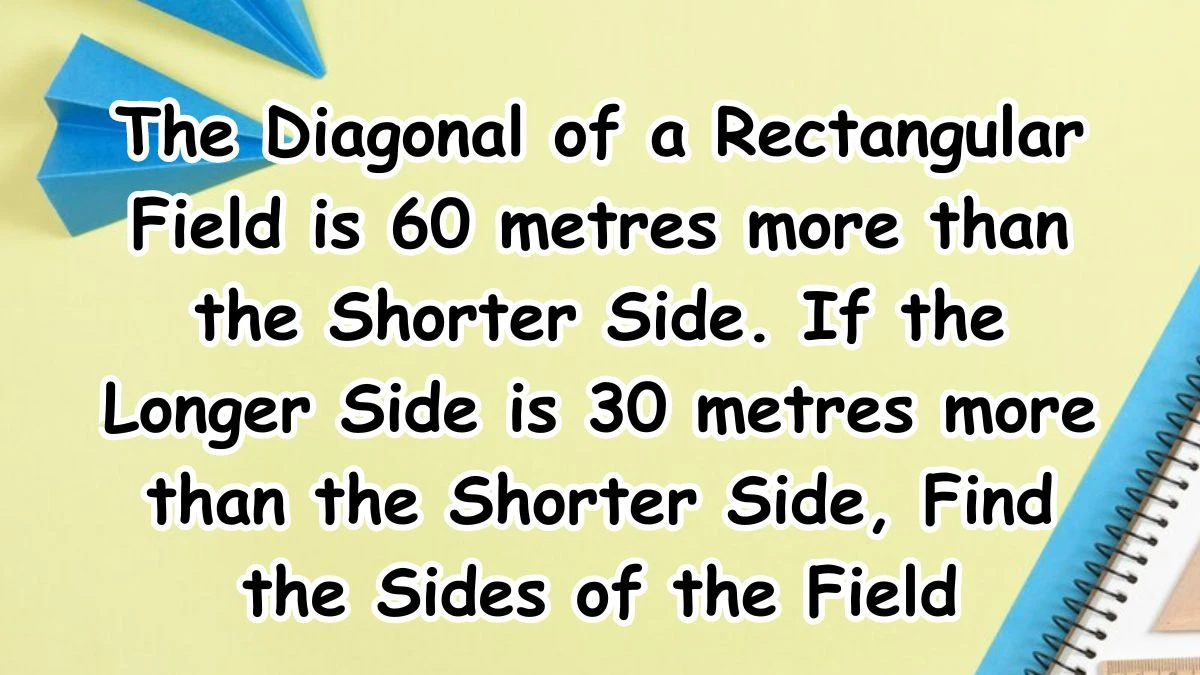The Diagonal of a Rectangular Field is 60 metres more than the Shorter Side. If the Longer Side is 30 metres more than the Shorter Side, Find the Sides of the Field
by
Updated Jun 07, 2024

The Diagonal of a Rectangular Field is 60 metres more than the Shorter Side. If the Longer Side is 30 metres more than the Shorter Side, Find the Sides of the Field
The problem involves finding the dimensions of a rectangular field given certain relationships between its sides and its diagonal.
The diagonal of the rectangular field is 60 meters longer than the shorter side.
The longer side is 30 meters longer than the shorter side.
Setting Up Equations:
Let's denote the shorter side as x meters. Then, the longer side is (x + 30) meters, and the diagonal is (x + 60) meters.
Using the Pythagorean theorem (a^2 + b^2 = c^2) for a right-angled triangle formed by the sides of the rectangle and its diagonal, we set up the equation x^2 + (x + 30)^2 = (x + 60)^2.
Solving the Equation:
Expanding and simplifying the equation gives us x^2 + x^2 + 900 + 60x = x^2 + 3600 + 120x.
Rearranging terms, we get x^2 - 60x - 2700 = 0.
Factoring the quadratic equation, we have (x - 90)(x + 30) = 0.
Solving for x gives us x = 90 (since a side length cannot be negative).
Calculating Side Lengths:
The shorter side of the field is 90 meters.
Therefore, the longer side is (90 + 30) meters, which equals 120 meters.
So, the sides of the rectangular field are 90 meters (shorter side) and 120 meters (longer side).
How to Solve Rectangular Field Dimension Problems Using Pythagorean Theorem?
In mathematics, problems involving rectangular fields and their dimensions often require the application of geometric principles and algebraic techniques. One common approach is to use the Pythagorean theorem, which relates the sides of a right-angled triangle, to solve such problems.
When dealing with a rectangular field, we typically encounter information about its diagonal and the relationship between its sides. For example, if we are given that the diagonal is a certain length longer than one side and that another side is a specific distance longer than the first side, we can set up an equation based on these relationships.
The Pythagorean theorem states that in a right-angled triangle, the square of the length of the hypotenuse (the side opposite the right angle, which in this case is the diagonal of the rectangle) is equal to the sum of the squares of the other two sides (the shorter and longer sides of the rectangle).
By setting up an equation using the Pythagorean theorem and the given information about the relationships between the sides and the diagonal, we can solve for the lengths of the sides of the rectangular field. This process involves algebraic manipulation, such as expanding and simplifying equations, factoring quadratic equations, and solving for unknown variables.
Once we have determined the lengths of the shorter and longer sides of the rectangular field, we can verify the solution and ensure that it makes sense in the context of the problem.




